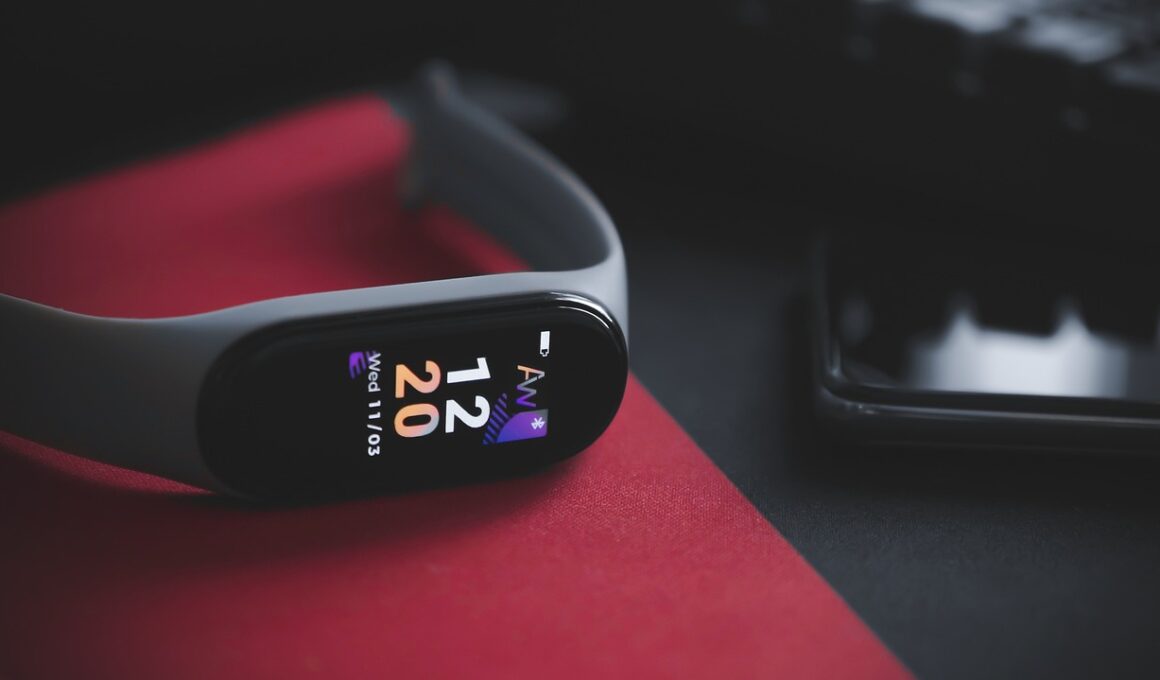Fitness Tracker Battery Life: What to Expect from Top Models
Understanding the battery life of fitness trackers is crucial for selecting the best model. Battery life can vary significantly between different brands and models, affecting their usability. Users generally expect fitness trackers to last several days without needing a charge. For example, some models boast up to 14 days of battery life, while others may require daily charging. Factors influencing battery life include display type, sensors, and usage frequency. Activity trackers with color displays usually have shorter battery durations compared to those with monochrome options. Additionally, GPS usage and heart rate monitoring can drain power more rapidly. When considering battery life, look for features that extend performance, such as energy-saving modes or notifications management. It’s essential to read reviews and compare specifications to find a fitness tracker that suits your needs. Ultimately, a well-informed choice enhances your tracking experience and reduces the hassle of frequent charging. By emphasizing battery durability, users can maintain their fitness regimens without interruptions or concerns about their device’s power levels. Smart usability is the key; therefore, explore options that strike a balance between features and longevity for seamless tracking.
Comparing Battery Life Across Popular Models
To provide a clearer picture, let’s compare the battery life of popular fitness trackers. The Garmin Forerunner series typically features up to 14 days for standard use. This range is ideal for athletes who need continuous tracking during prolonged periods. In contrast, the Fitbit Charge models generally offer about 5 days, making it suitable for casual users. However, intricacies in features often reveal how the battery performance can fluctuate. With constant GPS usage, many trackers will require more frequent charging, sometimes reducing lifespan to under a full day. Conversely, devices like the Apple Watch have options for battery saving that can extend life significantly beyond just normal usage. It’s vital to consider your anticipated use when selecting a tracker. Analyzing user feedback also reveals insights into real-world performance beyond manufacturer claims. Moreover, users should prioritize regular updates and compatible apps to help optimize battery efficiency, contributing to longer useful life. Consider how often you plan workouts, as excessive features may lead to reduced availability. Thus, compare various models based on your activity level to choose an appropriate device for fitness management.
The battery life implications extend beyond the simple charge frequency; they have critical consequences for overall user satisfaction. A fitness tracker that depletes quickly can interfere with daily routines and might inhibit a user’s motivation to stay active. Think about the practicality of everyday usage; if a device cannot keep up, it becomes less reliable as a fitness companion. Users encountering battery limitations may miss essential data during workouts or fail to get timely notifications during important events. Moreover, the frustration of a dead device affects not only the tracking results but also the user’s commitment to a fitness regime. Therefore, the significance of choosing a model with strong battery life cannot be overstated. Investigate options that provide customizable settings to maximize battery usage, giving you greater control over power consumption. It’s important to remember that consistent tracking leads to more significant health benefits and accountability in one’s routine. Implementing strategies like putting your tracker in power-saving mode during less active periods can even extend life effectively. The goal is to empower your fitness journey through smart choices regarding the device you select, ensuring it matches your lifestyle preferences.
Maximizing Battery Life through Smart Usage
Ultimately, fitness tracker longevity hinges not only on the device’s specifications but also on user habits. One common strategy is setting notifications and alerts sparingly; this helps conserve power. Selecting a device with customizable screens also aids battery longevity; users can avoid unnecessary use of high-drain features. Regularly updating your fitness tracker’s firmware ensures that you’re benefiting from the latest optimizations provided by the manufacturer. Often manufacturers roll out updates designed to improve energy efficiency, an aspect not always visible in initial specifications when trying to understand battery performance. Additionally, conducting periodic charging and keeping the device within an optimal temperature range can extend battery performance. Frequent exposure to extreme temperatures may impact battery life negatively. Using your tracking features strategically is another effective approach since constant active monitoring can drain the battery. Identify features that are pivotal for your specific needs; unnecessary use of advanced options may lead to diminished functionality over time. Moreover, keeping your device clean enhances its performance and can impact battery efficiency. Regularly check for firmware updates and maintain it well to eventually enhance your overall tracking experience.
Checking user reviews can also shed light on real-life battery performance and longevity. Investigating user experiences gives insights into durability and performance over time, offering a deeper understanding of the overall cost of ownership. Many reviews detail individual usage patterns and results, allowing prospective buyers to gauge whether specific models meet expectations. Consider professional reviews from fitness devices’ experts; they often conduct extended tests and can provide an unbiased perspective. Online forums and communities related to fitness technology can also be invaluable resources, as users share tips and tricks for enhancing battery life and maximizing usability. Furthermore, regularly checking manufacturer announcements may introduce relevant innovations that improve battery performance; this keeps users informed and engaged with their chosen fitness models. If your tracker performs optimally, this potentially boosts your motivation for maintaining an active lifestyle. Always remember that with the right knowledge, you can make informed choices that not only enhance your fitness experience but also ensure that your device supports your health journey effectively. The right fit between features and battery performance becomes integral to a successful long-term relationship with your fitness tracking device.
The Future of Fitness Tracker Battery Life
As technology progresses, we can anticipate significant improvements in fitness tracker battery life. Emerging technologies promise advancements in battery efficiency, enabling devices to provide longer service without excessive charging. Lithium-ion batteries are already a standard, but future innovations may include alternative materials that offer superior power retention. More brands are focusing on eco-friendly battery options, which could provide longer life while minimizing environmental impact. In addition, designs incorporating solar harvesting technology may see mainstream adoption, allowing devices to charge naturally while users engage in outdoor activities. This fuel-efficient charging approach pairs perfectly with users’ expectations in today’s fast-paced world. Moreover, as software improves, the integrated power management systems will likely become smarter, dynamically adjusting performance based on user habits and activity levels. Finally, the interaction of fitness trackers with other devices, like smartwatches or smartphones, may optimize power sharing, further extending overall usability. Together, these anticipated developments suggest an exciting future for fitness technology. You can expect wearable devices to evolve towards greater efficiency, making fitness tracking not just practical but seamlessly integrated into active lifestyles.
Signing off, the exploration of current fitness tracker battery life reveals important considerations for any potential buyer. Consumers should prioritize understanding how long a fitness tracker can effectively serve based on their own usage patterns. Whether you’re a casual user or a dedicated athlete, the right balance between features and battery longevity is essential. Ultimately, data accuracy and timely notifications influence workout success, making battery functionality a cornerstone of user satisfaction. Gaining insights from various models greatly enhances decisions that can affect health outcomes. Never underestimate the impact that battery life can have on overall motivation and engagement levels in your fitness journey. Choosing wisely will lead to a satisfying and enduring relationship with your selected fitness device. Consider good maintenance and optimal usage practices to ensure the longevity of your device. Ultimately, making an informed decision will guide you toward incorporating a fitness tracker that truly enriches your active lifestyle and helps you meet health goals efficiently. With the advice and comparisons provided, you’re empowered to enhance your fitness journey through the ideal tracking device.
Seek understanding when choosing the optimal fitness tracker that fits your personal needs and lifestyle. With rapidly changing technology, it’s critical to stay updated on battery life advancements and emerging features that can enhance the overall user experience. Review essential specifications before committing to a purchase, ensuring you’re making an informed decision. Knowledge about what to expect in battery durability, usage, and maintenance encourages active participation in daily fitness routines. Ultimately, maintaining a consistent track record can lead to significant improvements in health and well-being. Therefore, seek technology that not only satisfies basic fitness requirements but also encourages sustainable activity tracking. Assess how battery life will affect your intended usage, ensuring you select a model that aligns with your specific goals. By understanding the interplay of battery performance and device features, you will optimize your overall investment in fitness tracking technology. Your fitness journey deserves the support of an efficient and reliable tracking partner that helps you achieve your personal health objectives. Choice and functionality should coexist to facilitate a balanced approach to successful fitness management.


